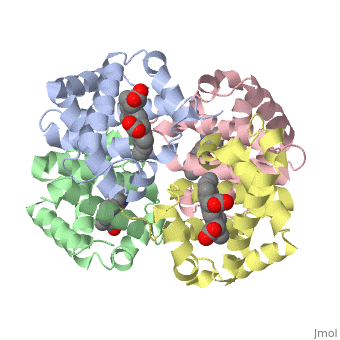Introduction to protein structure
From Proteopedia
(Difference between revisions)
| Line 20: | Line 20: | ||
== Ways of representing protein structure == | == Ways of representing protein structure == | ||
| - | Protein structures can be displayed in many different ways. In <scene name='57/575866/Spacefill_segment/1'>spacefilling</scene> models, all of the non-hydrogen atoms are shown as spheres with their van der Waals radii. In the <scene name='57/575866/Ball_and_stick_segment/1'>ball and stick</scene> model, the atoms are shown as smaller balls, connected by sticks; this is further simplified in the <scene name='57/575866/Stick_segment/1'>stick</scene> model, which only shows the bonds between atoms. <scene name='57/575866/Backbone/2'>Backbone</scene> shows only the N-Calpha-C=O repeating unit; the <scene name='57/575866/Cartoon/ | + | Protein structures can be displayed in many different ways. In <scene name='57/575866/Spacefill_segment/1'>spacefilling</scene> models, all of the non-hydrogen atoms are shown as spheres with their van der Waals radii. In the <scene name='57/575866/Ball_and_stick_segment/1'>ball and stick</scene> model, the atoms are shown as smaller balls, connected by sticks; this is further simplified in the <scene name='57/575866/Stick_segment/1'>stick</scene> model, which only shows the bonds between atoms. <scene name='57/575866/Backbone/2'>Backbone</scene> shows only the N-Calpha-C=O repeating unit; the <scene name='57/575866/Cartoon/2'>cartoon</scene> representation shows the secondary structures. |
'''Questions based upon these scenes:''' | '''Questions based upon these scenes:''' | ||
| Line 34: | Line 34: | ||
== Secondary Structures == | == Secondary Structures == | ||
| + | In this section, you will both learn about secondary structure properties and manipulating structures in Jmol. We will begin with some basic manipulation strategies so that you can analyze secondary structures. Try the following manipulations with the mouse: | ||
| + | --Click and move the mouse to the right, the left, up, and down; what happens to the molecule? | ||
| + | --Hold the shift button while you try the same manipulations. What does each do? | ||
| + | |||
| + | Clicking the right mouse button brings up an extensive menu. This exercise will use commands in the style, color,zoom, measurements, and set picking categories. | ||
| + | |||
| + | We will begin with the <scene name='57/575866/Cartoon/2'>cartoon</scene> structure of an alpha helix. From this view, can you determine: | ||
| + | --The number of amino acids per turn? | ||
| + | |||
| + | --The position of the side chains? | ||
| + | |||
| + | Hold the mouse over each end of the alpha helix. A yellow box should appear, with [VAL]17:A:CA:#120. This indicates the amino acid residue, the position in the chain, which chain, what atom it is (CA means the alpha carbon), and the overall number of the atom. If there are two identical chains, one of the chains may be numbered slightly differently (like adding 200 to each residue number) to distinguish the residues. | ||
| + | --What is the amino acid range (numbers) of this alpha helix? | ||
| + | |||
| + | Rotate the helix so that you are looking down the helix. What does the middle of the helix look like? | ||
| + | Right click on the mouse, choose, style, then scheme, then CPK spacefill. | ||
| + | -- | ||
</StructureSection> | </StructureSection> | ||
Revision as of 13:47, 16 January 2014
Levels of Protein Structure
| |||||||||||
Proteopedia Page Contributors and Editors (what is this?)
Ann Taylor, Joel L. Sussman, Alexander Berchansky, Eric Martz, Israel Hanukoglu, Jaime Prilusky, Nick Kenworthy

